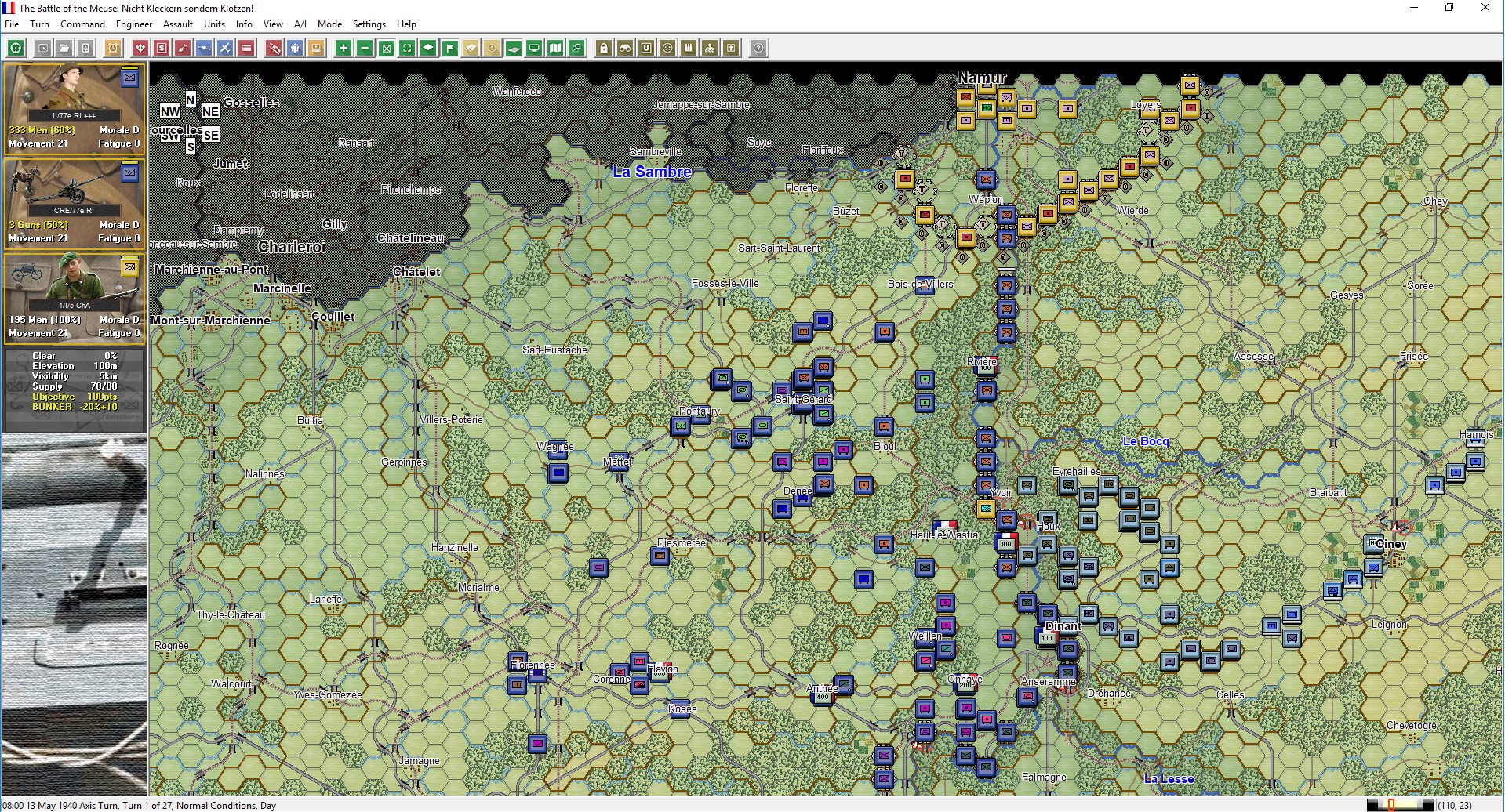France ’40 Gold – Play test on the Meuse
Mike Prucha and David Michas, the two dynamos behind the upcoming France ’40 Gold update have been deep into a play test of one of the new scenarios.
Before we dive into their after-action report, it’s worth mentioning that the update to France ’40 goes way beyond the scope of a normal Gold upgrade. To date there are an additional 40(!!) scenarios taking the total included in the game to 90. This is essentially a brand-new title with Holland now included with commensurate scenarios, as well as completely revised orders of battle based upon the latest research resulting in new versions of previously included scenarios. The inclusion of fragile morale as well as ‘surrender’ hexes adds a lot more to the tools available to the scenario designer.
Overall, I’m personally looking forward to playing some of these new scenarios.
Mike and David played the scenario The Battle of the Meuse: Nicht Kleckern sondern Klotzen! This is a 27-turn medium sized scenario starting on May 13th.
Here is the player's commentary – Mike Prucha playing as the Germans;
4. Armee - Namur to Revin
VIII. AK & XV. AK. (mot.) (Namur to Dinant)
Hoth's XV. AK (mot.) very quickly overran the French defenses on the Meuse in the Dinant sector on the 13th. Westward progress slowed on the 14th and 15th as more French units arrived. By the end on the 15th the French had been entirely dislodged from the Meuse from the Namur fortresses to Dinant by an average of about 11-12 km. The furthest German advance in the sector is from the lead elements of 7. Panzer, 18 km beyond the Meuse (just shy of Flavion.) The French in this sector have taken massive casualties. The 18e DI has all but but disappeared and the 5e DIM and 4e DINA also seem to be on the verge of collapse. 7. Panzer's advance falls well short of history - lead elements had made it all the way to Philippeville on the 15th. The progress north of Dinant (IIe CA), however, far exceeds history. Historically, more of 5e DIM remained intact at this point and they had not been forced back so far from the Meuse. The increased northward progress at the extent of westward progress is largely my doing - I became concerned over the vulnerability of XV. AK's northern flank and sent 5. Panzer north to break up of a potential counterattack. The result was that I cleared the entirety of the Meuse in this sector very rapidly but lost "hitting power" in my efforts to break through the French lines in the west.
Here's the sector held by 5e DIM & 18e DI on the Meuse from the Namur fortresses to Dinant on 5/13 and 5/15. XIV. AK (mot.) is present on the Meuse on May 13th, they will be followed by the infantry of VIII. AK. The French only have an advance detachment of the 18e DI on the river, the rest is marching toward Dinant along with 4e DINA. By May 15th, the French have been pushed back far from the river and the connection to the Belgian fortress position has been severed. Though the Germans have not broken through, the remaining French have been bled down to almost nothing. Only a few elements of 1re DCr are fresh. Another day would have seen the Germans clean up the broken and disrupted defenders and sweep very far to west.
Turn 1 (all images can be clicked for full size)
Turn 27
I. AK (Givet sector)
This sector played out close to history. 32. ID arrived on the 14th and pushed the 22e DI back from the Meuse quickly. By the end of the 15th the French have ceded a substantial distance and the 22e DI cannot put up an effective resistance. 32. ID was about a half day late to the Meuse - it might be worth advancing them a few km at the start of the scenario, so they can arrive sooner.
XVIII. AK (south of Givet to Revin)
- Gebirgsjaeger attacked 61e DI on the morning of the 15th. The previous day I had secured a bridghead over the Meuse north of Fumay with a small advance party of corps engineers and recon troops. On the 15th the Gebirgsjaegers were able to advance all the way to the Fourmies-Givet road, in the rear of 22e DI. I departed from history by ignoring Revin - I concentrated more forces at Fumay. Progress exceeded history - really the mountain troops didn't get much beyond the river. I think this was due to my decision to concentrate more forces at Fumay and the bridgehead I established before the division's arrival.
Here's the section of the Meuse from Givet to Revin, held by 22e DI and 61e DI. Once the Germans arrive, they will be opposed by 1. Gebirgs & 32. ID with a few other divisions arriving at the end of the scenario. By May 15th both divisions have lost about 9-10 km and have suffered severe casualties. A few battalions from 32. ID took substantial losses crossing the Meuse, but otherwise the division is intact. Losses to the Gebirgjaegers are negligible
Turn 1
Turn 27
12. Armee - Monthermé to East of Sedan
XXXIX. AK & III. AK (Monthermé & Nouzonville
This sector played out very close to history. 6. Panzer's advance was severely hampered by the claustrophobic terrain and well-placed French bunkers. Little progress was made in the Monthermé sector on the 13th and 14th. 3. ID. attacked Nouzonville on the 14th-15th (historically the attack did not begin until the morning of the 15th) while 6. Panzer finally extricated itself from Monthermé. These divisions have advanced well beyond the river. To the south 23. ID has crossed the Meuse into a vacuum. the 102e DIF is all but destroyed. 8. Panzer, which only arrived on the Meuse at the very end of the day on the 15th, has exploited the crack in the French defenses and in just a couple of turns has advanced deep into the French rear areas (though they will not make it to Montcornet). Historically it was 6th Panzer rather than 8. Panzer that advanced the furthest and exploited the French break, but things played out a bit differently - David deployed reinforced the Monthermé-Nouzonville sector with the entire 53e DI (historically it was just 1 regmiment of 61e DI - 53e DI was sent south to the Ardennes canal). Nonetheless, these additional French troops probably only set me back about a half day - 6. Panzer & 3. ID have pushed the reserve division back 10 km and are on the verge of generalized breakthrough.
Below is the sector from Monthermé to Charleville-Mézières, defended by 102e DIF and later backed up by 53e DI. Late on May 13 the sector will be attacked by 6. Panzer later joined by 3. ID, 23. ID, and in the last turns of the scenario 8. Panzer. Though the French do not have a large number of troops deployed to this sector, the bunkers are well-placed, and the terrain is not favorable for Panzers. Very little progress was made in this sector on the 13th and the most of the 14th - it was not until evening on the 14th that 3. ID was able to cross the Meuse at Nouzonville (historically it was on the morning of the 15th) and then the situation deteriorated very rapidly for the French. The Germans were successful in wrenching a 14 km hole in the French lines through which plunged the advance elements of 8. Panzer & 6. Panzer. Every unit in 53e DI is disrupted and 102e DIF has been reduced to little more than a battalion. Motorcyclists of 8. Panzer ran into 6e armée headquarters on the last turn.
Turn 1
Turn 27
XIX. AK (mot.) (Sedan)
As XIX. AK sat fixed for the first few turns I use almost all available air power to hit the French at Sedan and in the rear areas. XIX. AK riflemen then crossed the Meuse in boats and rapidly overwhelmed the French defenses. A bridge was constructed that night. The 14th was spent pushing further south and west. 1. Panzer arrived at Chémery on the evening of the 14th - this was about 4 turns behind history (David sent 5e DLC to counterattack rather than taking up defensive positions behind the Bar River, slowing me down just a few turns. On the 15th I worked to breakout to the west. I was never able to break through quite like the Germans did, though I was close. 1 more day would have done it. This is entirely because of David's more efficient use of the 2e DCr. Historically the division was issued a series of contradictory orders and counter orders which left its elements dispersed over a wide area - the French generals had effectively dismantled their own division. David concentrated the division behind the Bar - 2. Panzer's route was blocked by a cluster of heavy B1 bis tanks. Had those heavy tanks not been deployed there the result would have been very different, but a human French player can of course use the division how he pleases.
The Sedan sector; On May 13th Sedan is held by the 55e DI - an exceptionally weak Series B division. To its right is the 71e DI, also a weak Series B division. They are opposed by Guderian's XIX. AK (mot.), consisting of 1. Panzer, 2. Panzer, 10. Panzer, I.R. Grossdeutschland, and an array of corps and army artillery, engineers, and other assets. 55e DI was swept aside very quickly and the German advance was unstoppable for the first few days. As the Germans peeled two Panzer divisions the west and the French funnelled reinforcements to the Sedan area the advance gradually slowed before being halted in front of Stonne. 1. Panzer and 2. Panzer encountered heavier resistance west of the Ardennes Canal than they historically did. The French player handled 2e DCr much more effectively then the real French command did and deployed the 36e DI and eventually 14e DI in the Panzers path - historically these were mostly deployed on the Aisne to block any southward advance to Paris. The broken remains of 55e DI can be seen behind the French lines at Stonne.
Turn 1
Turn 27
Finally, the jump maps showing the overall situation before and after. The thickness of the blue line on the north end of the map is deceiving - nearly all units in that sector are badly understrength, most disrupted and many broken.
Turn 1
Turn 27
David Michas commentary playing as the French (appropriate as David is French!)
"Philippeville, Belgium, May 15, 1940.
I am writing to you by candlelight, workers of the Communist Party of Belgium had the good idea to cut the power plant cables. I just put my steel helmet down, mouth full dust and powder, blood is flowing from my ears, everything is fine.
You shouldn't listen to Radio Berlin propaganda relayed by Mike, bullshit!
In three days, it is estimated that the losses of Nazi troops doped with Pervitin amounted to more than 10,500 guys, at least 270 vehicles out of action.
On the Meuse we were facing a diversionary manoeuvre, the real battle was taking place further north, in the plains of Belgium..."
Mikes feedback;
So, here's what we've learned;
- The final result was a German major victory - based on the ground I gained I really only wanted it to be a minor victory. I had tried to account for force destruction in the victory conditions but did not account for enough force destruction. I will have to bump the threshold for major victory up a bit in this scenario and probably the Grand campaign and Dunkerque pocket as well.
- The only thing that prevented a larger German breakthrough was David M's more efficient handling of the DCRs and my mistake in dispersing XV. AK. Against the A/I, I have placed a series of orders to model the French command's misuse of the divisions (especially 2e DCr), but a human player is of course free to use them how he pleases. It might be worth creating a second version of the scenario with some action taken to further hamper a human player's effective deployment of the armored divisions - perhaps a couple of fixes and releases to slow their deployment.
- Some thoughts on Fragile morale. Overall, I think the Fragile morale feature is working very well and fulfilling its intended purpose. The disruption effects are palpable and had a huge impact on badly spread low quality units - this severely diminished the French player's ability to organize an effective defense in places. The surrender effects also played an important role - I could not have cleared the Meuse as quickly if I had to assault each isolated company 2-4 times over almost as many turns. There were several instances in which lower quality units were rapidly overwhelmed as soon as the Panzer got around them - this seemed like realistic behavior for the opening stages of the 1940 campaign. That being said, I think the surrender effects might go a little far - I would prefer more contrast between some units giving up once the Panzer get behind them while others give a more stubborn/protracted resistance even when isolated. I see three options:
- Leave things as they are - the fragile effects are intended to help facilitate a historic result and they are succeeding.
- Choose more French units to be Quality B. This would exempt more units from the surrender effects. This would be the easiest route if we wanted a change here, but I am concerned that too many Quality B units will make things too difficult for the Germans. We would have to be very selective and sparing.
- Ask if we can have the Fragile morale altered so that that Quality C units will be exempt. The reservists on the Meuse would still suffer from the fragile effects (which I find highly desirable) but the active reinforcements would be made more capable without resorting to giving them an equivalent quality rating to the Germans. The overall effect would be that a little more than half of the French army would suffer from fragile effects (including most of the 2nd and 9th armies in the critical sector on the Meuse) while a substantial portion (including the 1st Army) would not. The Belgians and Dutch would be relatively unaffected as they are mostly D & E anyway.
I would prefer option A or C, though I am not opposed to B - it would just have to be implemented quite judiciously if we go that route. I would really like to hear any thoughts from David M on the fragile morale feature after having play tested it and any thoughts from David F or others.
David’s feedback;
So, I enjoyed this game, this game is a killing!
I even managed to take about fifty prisoners from 71. ID right away, it's to tell you. ;)
I'm just a little disappointed by the lack of punch of my anti-tank tubes, maybe related to morale or a lack of luck.
I "object" to this rule of fragile morale, except in Bulson, after the Luftwaffe's bludgeoning and the fake rumour of the arrival of the German tanks, the French army did not behave, for example like the Belgian army with mass surrenders. Or this rule must apply to all opponents of the German army, from 39 to 43?
What is embarrassing is that this rule is not fluctuating. We can never harden up during the game a troop with this fragile morale, c'est pour toute la vie :)
We have included the scenario feedback as it shows some of the things we have to think about as we design various situations, particularly with the new rules that are now available.
I hope this gives you all another insight into what, will be a superb new title when released.
















Leave a comment